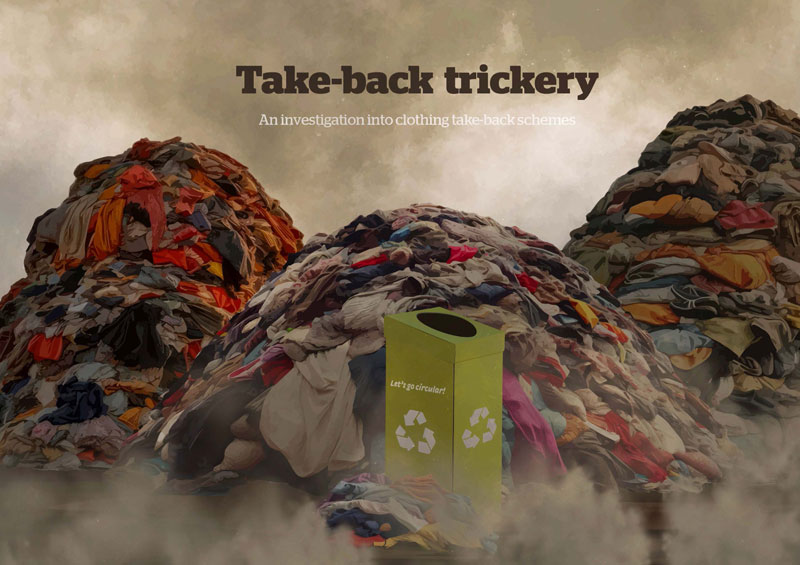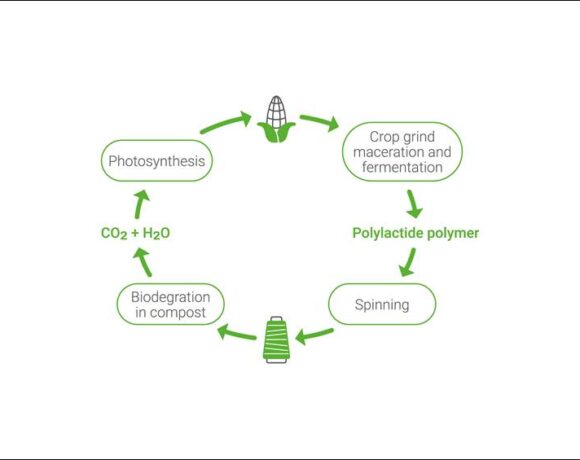Take-Back Trickery: Unraveling Greenwashing In Clothing Take-Back Schemes

Fast fashion’s rise has brought with it a slew of environmental challenges, due to its rapid production of cheap garments and ever-changing fashion trends. The disposable nature of fast fashion contradicts the concept of a circular economy, exacerbating environmental issues and exploitation of workers. Synthetic materials, which dominate the industry, make recycling and reusing clothing difficult, resulting in overflowing landfills and microplastic pollution. Take-back schemes have emerged as a potential solution to this crisis, offering consumers the chance to return used clothing for recycling or reuse. However, their efficacy and transparency are now under scrutiny, raising questions about whether they truly address the fast-fashion problem or are merely a form of greenwashing.
From Trendy to Trash: Fashion’s End-of-Life Challenges
Fast fashion’s appeal lies in its affordability and ability to keep up with ever-changing trends. However, the dark side of this industry is its environmental impact. The reliance on synthetic materials derived from fossil fuels leads to a vast amount of non-biodegradable waste that pollutes the environment and threatens ecosystems. Moreover, the sheer quantity of discarded clothing overwhelms recycling efforts, as the technologies are still in their infancy, leaving less than 1% of used clothing recycled into new garments. This unsustainable practice has led to an alarming amount of fashion waste ending up in landfills or incinerators.
The Rise of Take-Back Schemes
In response to mounting pressure to address fashion’s environmental footprint, an increasing number of brands have launched take-back schemes. These initiatives allow consumers to return their used clothing, with the promise that it will be recycled or given a new life. The appeal of these schemes lies in the idea of moving towards a circular model, where clothing is continually recycled, thereby reducing waste and conserving resources.
A Closer Look at Take-Back Schemes
Despite the noble promises made by brands, the reality of take-back schemes is not always as promising as portrayed. Many brands collaborate with charity organizations or commercial partners to handle the collected clothing, which reduces their direct oversight over the recycling process. Consequently, transparency is often lacking, making it difficult to track what happens to the collected items.
Unraveling the Greenwashing Effect
One significant concern with take-back schemes is their potential to perpetuate greenwashing. While these initiatives may create the illusion of sustainability, they can also inadvertently encourage consumers to buy more cheap clothing. Brands offer incentives such as discounts, gift cards, and loyalty points, which can prompt consumers to participate in the schemes and subsequently purchase new clothing, further fueling the fast-fashion cycle.
The investigation
Over the 11-month period from August 2022 to July 2023, the Changing Markets Foundation (CMF) investigation utilized a combination of methods, including desk-based research, trade data analysis, tracking software, and collaboration with partner organizations.
CMF purchased 21 second-hand clothing items from vintage and charity shops, all in good condition without visible damage, to represent a realistic scenario of consumer returns. Criteria for selecting these items included choosing brands with take-back schemes under investigation and concealing trackers within the fabric. The clothing contained synthetic fibres like polyester, nylon and elastane, reflecting the typical fibre mix found in fast-fashion items.
For tracking, discreet airtags were used, easily concealed within the clothing, and tracked from investigators’ phones using Bluetooth connections. The locations of the trackers were recorded periodically.
Of the 21 items, 4 were deposited with take-back schemes in France, 11 in the UK, 4 in Germany, and 2 in Belgium, handed over at various stores of H&M, Primark, M&S, C&A, North Face, and Zara. Postal take-back schemes from the UK were utilized for Boohoo and New Look.
Based on their journeys and outcomes, CMF categorized the tracked items into four distinct groups.
Category 1: Destroyed or downcycled
In this category, at least seven clothing items were found to have been destroyed, downcycled or dumped, undermining the promises made by brands in their take-back schemes. For example, a new pair of Zara trousers deposited in a C&A collection bin in Paris ended up at a specialized facility in Germany, where it was likely shredded within a month, despite being in excellent condition. Similarly, an H&M sweater deposited in Berlin followed a similar path, ultimately being downcycled or disposed off in a Czech Republic facility.
These findings raise concerns about the missed opportunities for reusing perfectly wearable clothing. The downcycling process fails to address the root cause of overconsumption and the continuous production of new clothing, leading to further waste generation.
Category 2: Resold Within Europe
Five items of clothing were successfully resold within Europe, either in second-hand shops or to customers on the same continent. Notably, a shirt deposited in a Zara shop in London found its way to a British Red Cross second-hand store in northwest England, demonstrating a positive case of reuse within the same country.
However, it was evident that reselling within the same country was not the norm, as most items traveled across multiple countries, covering thousands of kilometres. This inefficient process raises questions about the true sustainability and environmental impact of these take-back schemes.
Category 3: Lost in Limbo
Eight clothing items were either stuck at the drop-off point or remained in limbo within the global used clothing system. In some instances, trackers never left their point of deployment, while others were left in intermediary warehouses for extended periods. This inefficiency suggests that many items consumers expect to be reused or recycled are instead languishing in warehouses across Europe.
Category 4: Shipped to Africa
The most contentious category involved trackers that were eventually shipped to countries in Africa. While four of the tracked items were intended for reuse, the investigation found that this fate rarely materialized. Trackers revealed that clothing items often ended up in low-grade clothing markets or dumpsites, contributing to the issue of textile waste in the Global South.
Brands like C&A and H&M emerged as concerns in this investigation, with their take-back schemes leading to items ending up in Africa. This not only raises ethical concerns about the export of used clothing to developing countries but also highlights the lack of accountability of brands for the items shipped there.
Conclusion
The investigation into clothing take-back schemes has revealed major flaws in the system that is grappling with the overwhelming volume of clothing waste. While brands often promote these schemes as a solution for circularity, CMF research shows that they are failing to live up to their commitments. Instead of promoting true sustainability, these take-back schemes create an illusion that the fashion industry is effectively dealing with its waste problem.
CMF’s findings highlight several scenarios of serious concern. Garments in excellent condition are being shredded and incinerated, contradicting brands’ claims of reuse and recycling. Some clothing items take long, inefficient journeys across multiple countries, contributing to environmental pollution. Worse still, clothing shipped to the Global South often ends up in low-grade markets, adding to the waste crisis in those countries that are ill-equipped to manage such pollution.
Take-back schemes are being used as a form of greenwashing, allowing brands to appear environmentally responsible while avoiding meaningful systemic changes to address fast-fashion’s wasteful model. Incentives offered to customers, such as vouchers or discounts for dropping off used clothing, perpetuate the excessive consumption and waste-driven by fast fashion.
While CMF’s investigation focused on 21 tracked items, it likely reflects broader systemic issues and the flawed nature of take-back schemes lacking transparency and accountability. The relentless production of low-quality clothing exacerbates the challenges surrounding end-of-life management.
To address these issues, the fashion industry must wake up and align itself with upcoming regulations that will hold it responsible for end-of-life treatment and textile sorting before shipment abroad. Regulations should also combat greenwashing tactics, requiring brands to substantiate their claims about take-back schemes.
Amidst these challenges, there is hope in the potential for clothing reuse and fibre-to-fibre recycling technologies. Policymakers must seize this opportunity to support and incentivize these practices to achieve commercial-scale maturity.
Fashion companies themselves are signaling their support for ambitious reuse and recycling targets and a mandatory EU-harmonized Extended Producer Responsibility (EPR) scheme for textiles. Policymakers must heed these signals and work towards a sustainable and efficient textile waste management system for the future.
In conclusion, the current state of clothing take-back schemes demands urgent action to avoid exacerbating the clothing waste crisis and instead pave the way for a more sustainable fashion industry. Only by addressing the root causes of waste and promoting true circularity can the industry move towards a more environmentally responsible future.
(Changing Markets Foundation)














